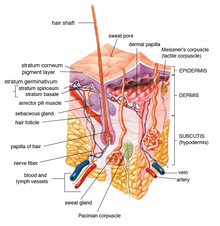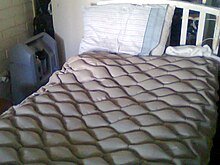Open Source Handbook of Nursing/Skin Integrity
Integumentary system
[edit | edit source]The skin or integumentary system

Functions of skin
[edit | edit source]The integumentary system serves as a protective barrier; the skin helps to regulate the body temperature by several mechanisms. These mechanisms consist of:
Protection
- Abrasion, invasion, water loss, UV protection
Vitamin D synthesis
- Epidermal keratinocytes when exposed to UV light helps maintain health of skeleton by increasing absorption of Ca2+
Sensation
- Receptors for heat, cold, touch, pressure, vibration and pain
Thermoregulation
- Thermo receptors and sweat glands
- Hypothalamus controls cutaneous arteries and sweat glands to retain or dissipate heat
Psychological and social functions
- Appearance and social acceptance
- Facial expression and nonverbal communication
Epidermis
[edit | edit source]The epidermis is composed of the outermost layers of cells in the skin which together with the dermis forms the cutis. The epidermis is a stratified squamous epithelium, composed of proliferating basal and differentiated suprabasal keratinocytes which acts as the body's major barrier against an inhospitable environment, by preventing pathogens from entering, making the skin a natural barrier to infection. It also regulates the amount of moisture released from the body by diaphoresis (sweating).
The epidermis has no nerves or vessels. It is nourished by diffusion from the dermis. The epidermis constists of
- keratinocytes (95% majority)
- melanocytes
- Langerhans cells
- Merkel cells
Rete ridges (wrinkles) are epidermal thickenings that extend downward between dermal papillae. These are or interest to nurses where they can be mapped as "Langer's lines" indicating the direction in which they usually lie. "Crow's feet" at the outer edge of the eyes is an example of skin wrinkles which typically allow movement in one direction. Incisions along these lines will leave the least obvious scar, while incisions across these lines will cause dog-eared puckering of the healed skin.
Blood capillaries are found beneath the epidermis, and are linked to an arteriole and a venule.
Dermis
[edit | edit source]The dermis is the largest layer of skin between the epidermis and the hypodermis which is responsible for giving the skin its structural support. The dermis consists of white fibrous tissues containing elastic fibers to allow the skin to stretch. It also contains blood vessels, lymph vessels, hair follicles and glands that produce sweat. This helps regulate the body temperature and keeps the skin from drying out. [Tabbners Nursing Care, 5th Edition, Chapter 37, Page 617]
Hypodermis
[edit | edit source]The hypodermis is the innermost and thickest layer of the skin, it is specialised in accumulating and storing fats, known as adipocytes it also acts as an energy reserve.
Its purpose is to attach the skin to underlying bone and muscle as well as supplying it with blood vessels and nerves also its Fat serves as padding and insulation for the body.
The hypodermis also fastens the skin to the underlying surface, provides thermal insulation, and absorbs shocks from impacts to the skin.
Nerves
[edit | edit source]
Glands
[edit | edit source]Sweat glands include the apocrine gland which may act as a sex attractant also opens in to the hair follicle. Eccerine gland which control body temperture.
Nursing Problems
[edit | edit source]
Skin integrity can be defined as skin being whole, intact and undamaged. Poor skin integrity can lead to further complications such as pressure sores, infections and skin tears. Skin integrity can be assessed using the Braden Scale, the Norton Scale or the Waterlow Scale.
Maintaining skin integrity can be done by using a daily moisturizing pH balanced lotion to protect dry skin, avoid consistent contact with a wet environment, maintaining optimal hydration, maintaining good nutrition, maintaining mobility and avoiding falls.
Skin tears
[edit | edit source]A skin tear is the separation of the epidermis from the dermis or both the epidermis and the dermis from deeper structure. According to silver chain star classification system a tear can be classed into one of 5 categories: 1
- 1a (the edges can be realigned and the colour of the skin flap is normal),
- 1b (the edges can be realigned but the colour of the skin flap is pale, dark or dusky),
- 2a (the edges can not be realigned and the colour of the skin flap is normal),
- 2b (the edges can not be realigned and the colour of the skin flap is pale, dark or dusky),
- 3 (the skin flap is completely gone).
Parasites
[edit | edit source]Parasite : The skin is a primary site of infection, most parasites are harmless. All parasitic groups can involve the skin or subcutaneous tissue.Food and water are the most common sources of parasite and invading organism transmission.
Cancer
[edit | edit source]Burns
[edit | edit source]A burn is a type of injury to the flesh or skin, which is a part of the integumentary system of the body. Burns are one of the most serious skin injuries, as they not only disrupt physical function but as well can cause severe emotional trauma. Burns may be caused by
- Dry heat
- Electricity
- Moist heat
- Radiation
- Chemicals
Heat in contact with the skin causes coagulation of the protein in the tissue cells, and the depth of the burn, or the degree of the burn relates to the amount of thermal energy that comes in contact with the skin.
A burn is described as both being superficial, partial thickness or full thickness, and when the burn surface area is assessed often the rule of nines is used, which cuts the body into sections and is able to give a rough measure of percentage of body that contains the burn.
Nutrition
[edit | edit source]Skin integrity may be threatened by diet deficient in protein, Vitamin B2 or sulphur.
.
References
[edit | edit source]- Martin, E. (2008) A Dictionary of Nursing. Oxford University Press. UK
- Stainton,K., Hughson,J., Funnell,R., Koutoukidis,G. & Lawrence,K. (2008) Tabbner's Nursing Care. Elsiever. Australia.5th Edition, chapter 37, page 632
- David Moreau (Ed) (2008) Anatomy and Physiology Made Incredibly Easy. Lippincott Williams and Wilkins. South Australia
- Rothrock, J. (2010) Alexander's Care of the Patient in Surgery. Elseiver. Sydney.
- Smeltzer,S., Bare,B., Hinkle,J. & Cheever, K. (2009) Brunner and Suddarth's Textbook of Medical-surgical Nursing. Lippincott Williams and Wilkins. Tasmania
